365 GTC/4 Project Car
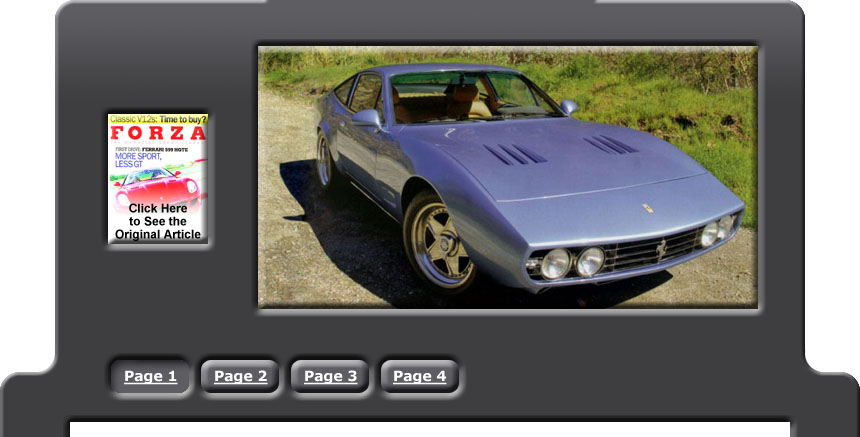
This Ferrari 365 GTC/4 has been specially modified by CAROBU Engineering. The modifications include a 5.0 liter C/4-412i hybrid engine, Brembo GT "Big Brake" kit, 17" Razzo Rosso wheels and height adjustable suspension. The C/4 is a "sleeper" Ferrari whose image was outshined by the popular Daytona. However, the elegant Pininfarina styling, and the steady road manners of the car made it an excellent basis for modification.
365 GTC/4 Background
The front engine/transmission Ferrari 365GTC/4 was introduced to the world at the 1971 Geneva Auto Salon as the replacement of the 365 GT 2+2. The C/4, as it is commonly known, had a distinctive flowing wedge-profiled body designed and built by Pininfarina in Turin. The C/4 body was comprised of welded steel panels and aluminum trunk and hood over a steel frame. The car was in production for 18 months with a production of a mere 500 cars.
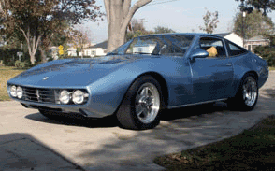
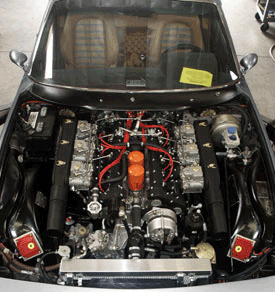
The plan included rebuilding the engine with a "balanced" combination of parts and modifications to produce a strong yet flexible power curve combined with street reliability. The paint/bodywork needed attention too; the front spoiler was smashed and the front and rear lids had bad fits on the right side. The paint was a quickie re-spray over the original factory black color and it looked tacky with various masking errors. Additionally, the "blackout" on the rear deck and door jams was done incorrectly.
C/4 – 412i Hybrid Engine
The goal of this project was to increase the power and torque of the engine while retaining the balanced character and stock appearance of the C/4. In order to accomplish this, it was elected to install the 5.0 liter engine from the later 412i. The 412i engine is based on the same basic block with raised deck height and made an excellent basis for the C/4 project. In stock form, the 82mm bore and 78 mm stroke results in a 4942 cc displacement. The 412 engine was rated at 340 hp at 6000 rpm in the original configuration. For this project, the stock C/4 Weber carburetors and air boxes were retained.
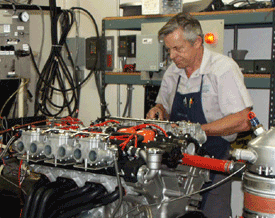
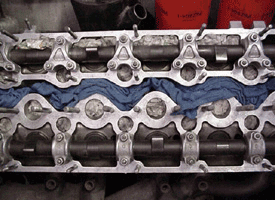
Heads and Camshaft
The plan included rebuilding the engine with a "balanced" combination of parts and modifications to produce a strong yet flexible power curve combined with street reliability. The paint/bodywork needed attention too; the front spoiler was smashed and the front and rear lids had bad fits on the right side. The paint was a quickie re-spray over the original factory black color and it looked tacky with various masking errors. Additionally, the "blackout" on the rear deck and door jams was done incorrectly.
To properly utilize the additional lift and duration provided by the CAROBU camshaft, the intake and exhaust ports were massaged to match the port flows with the camshaft. Computer simulation modeling was used in order to determine the ideal intake and exhaust flow profiles. Figure 1 illustrates the head flow, in cfm at 28" of water, of the intake and exhaust ports for the original 412i heads and for the "ported" 412i heads. The original heads flowed 127.2 cfm at 0.350" valve lift. After porting, the intake port flowed 144.7 cfm, and increase of 17.5 cfm or 13.8% increase over stock. The intake port positioned between the intake and exhaust cams and manifold configuration of the C/4 is less than ideal for engine breathing. For comparison, the 365 GTB/4 Daytona project engine, with a more advantageous intake port design, had an intake port flow @ 0.350" lift of 168.4 cfm at 28" of water. The exhaust ports of the heads were not ported as the computer simulation predicted that additional exhaust port flow would not improve the low speed torque of the engine. The exhaust port flowed 127.9 cfm at 28" of water.
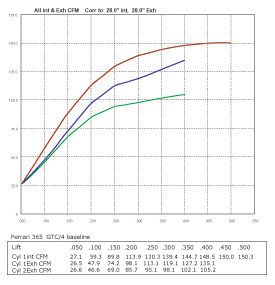
Flow Test Chart
Click here to enlarge




